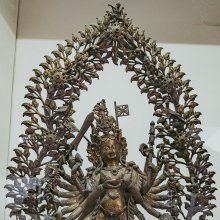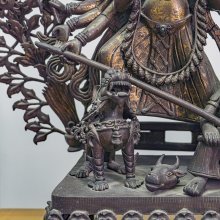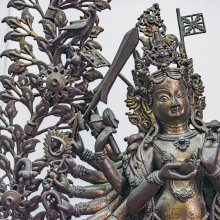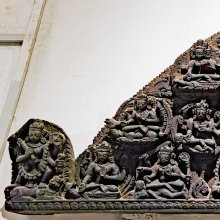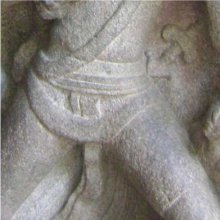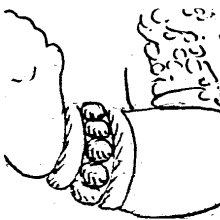Mahishasura, Mahiṣāsura, Mahisha-asura: 9 definitions
Introduction:
Mahishasura means something in Hinduism, Sanskrit. If you want to know the exact meaning, history, etymology or English translation of this term then check out the descriptions on this page. Add your comment or reference to a book if you want to contribute to this summary article.
The Sanskrit term Mahiṣāsura can be transliterated into English as Mahisasura or Mahishasura, using the IAST transliteration scheme (?).
Images (photo gallery)
(+3 more images available)
In Hinduism
Shilpashastra (iconography)
Source: Red Zambala: Hindu Icons and Symbols | DeviMahiṣāsura (or “the buffalo-demon”) represents the gross negative aspect of Tamas which obstructs and thwarts spiritual progress. As the personification of the Tāmasic Ahaṃkāra — he constantly and adroitly changes shape whenever he is confronted by Durgā.

Shilpashastra (शिल्पशास्त्र, śilpaśāstra) represents the ancient Indian science (shastra) of creative arts (shilpa) such as sculpture, iconography and painting. Closely related to Vastushastra (architecture), they often share the same literature.
Purana and Itihasa (epic history)
Source: Wisdom Library: Varāha-purāṇaMahiṣāsura (स्त्रीघ्न) is an Asura king who started the battle between the gods (devas) between the demons (asuras) in order to win over the hand of Trikalā, according to the Varāhapurāṇa chapter 94. Trikalā is a Goddess born from the combined looks of Brahmā, Viṣṇu and Maheśvara (Śiva). Mahiṣāsura faced Indra in battle whom he also defeated.
The Varāhapurāṇa is categorised as a Mahāpurāṇa, and was originally composed of 24,000 metrical verses, possibly originating from before the 10th century. It is composed of two parts and Sūta is the main narrator.

The Purana (पुराण, purāṇas) refers to Sanskrit literature preserving ancient India’s vast cultural history, including historical legends, religious ceremonies, various arts and sciences. The eighteen mahapuranas total over 400,000 shlokas (metrical couplets) and date to at least several centuries BCE.
General definition (in Hinduism)
Source: Apam Napat: Indian MythologyMahishasura was a mighty Asura, born to the King of Asuras named Rambha (different from the divine nymph Rambha). When Rambha was walking in the street, he saw a beautiful female buffalo. He was immediately smitten with desire and sated his lust on the poor animal. The demon Mahishasura was born of this union. In Sanskrit Mahisha=Buffalo.
He became the king of the Asuras after his father. As was the custom of the Asuras, he prosecuted a terrible war with the Devas. To help his kinsmen gain the upper hand, Mahishasura performed a tough penance directed at Lord Brahma. Pleased, the Lord granted a boon to him that death shall not approach him, save by means of a woman.
Source: Sri Kamakoti Mandali: HinduismAccording to tāntric lore, Mahiṣāsura first took birth in Raṃbhakalpa as the son of Raṃbhāsura. In that birth, he was slain by Parāmbā in her form as Aṣṭādaśabhujā Ugracaṇḍā who used a śvetakhaḍga to kill the demon. This form of Parāmbā is invoked through the famous Navākṣarī mantra.
Again, in the Nīlalohita kalpa, Mahiṣāsura took birth and this time, he was killed by ṣodaśabhujā Bhadrakālī who used a śvetabāṇa to destroy him.
Finally, he was born a third time in śvetavarāha kalpa but he remembered his previous births by the grace of sage Jaigīṣavya. Having realized the possibility of death again at the hands of Mahāmāyā , he resorted to ekānta bhakti (kāyika, vācika, mānasika) and immersed himself in the upāsanā of Parāśakti. After twelve-thousand years of upāsanā, Bhagavatī manifested before him and he addressed her thus:
Languages of India and abroad
Sanskrit dictionary
Source: DDSA: The practical Sanskrit-English dictionaryMahiṣāsura (महिषासुर).—the demon Mahiṣa. °घातिनी, °मथनी, °मर्दनी, °सूदनी (ghātinī, °mathanī, °mardanī, °sūdanī) epithets of Durgā.
Derivable forms: mahiṣāsuraḥ (महिषासुरः).
Mahiṣāsura is a Sanskrit compound consisting of the terms mahiṣa and asura (असुर).
Source: Cologne Digital Sanskrit Dictionaries: Monier-Williams Sanskrit-English DictionaryMahiṣāsura (महिषासुर):—[from mahiṣa > mah] m. the Asura or demon Mahiṣa (from whom the country of Mysore is said to take its name), [Religious Thought and Life in India 431]
[Sanskrit to German]
Sanskrit, also spelled संस्कृतम् (saṃskṛtam), is an ancient language of India commonly seen as the grandmother of the Indo-European language family (even English!). Closely allied with Prakrit and Pali, Sanskrit is more exhaustive in both grammar and terms and has the most extensive collection of literature in the world, greatly surpassing its sister-languages Greek and Latin.
Kannada-English dictionary
Source: Alar: Kannada-English corpusMahiṣāsura (ಮಹಿಷಾಸುರ):—[noun] (myth.) name of a demon who was slain by Cāmuṇḍi, whose country is now known as Maisūru or Karnāṭaka.
Kannada is a Dravidian language (as opposed to the Indo-European language family) mainly spoken in the southwestern region of India.
Nepali dictionary
Source: unoes: Nepali-English DictionaryMahiṣāsura (महिषासुर):—n. Mythol. 1. the buffalo-demon; 2. the great asura adversary of Durga; whose death at her hands is celebrated in the Devi Mahatmya;
Nepali is the primary language of the Nepalese people counting almost 20 million native speakers. The country of Nepal is situated in the Himalaya mountain range to the north of India.
See also (Relevant definitions)
Partial matches: Mahisha, Asura.
Starts with: Mahishasuraghatin, Mahishasuraghatini, Mahishasuramajjotha, Mahishasuramajjottha, Mahishasuramardini, Mahishasuramardinistotra, Mahishasurapaha, Mahishasurardini, Mahishasurasambhava, Mahishasurasthana, Mahishasurasudani, Mahishasurasudini.
Query error!
Full-text (+67): Mahishasuramardini, Mahishasurasambhava, Mahishasurasudani, Mahishasuraghatini, Mahishasurasthana, Mahishasuramajjotha, Katyayani, Mahisha, Udarka, Mahishasuramardinistotra, Bidala, Mahishasurapaha, Kalabandhaka, Mahishasurardini, Makitacuran, Mhaisasura, Mhasasura, Trinetra, Makitacuramarttani, Mahisasur.
Relevant text
Search found 39 books and stories containing Mahishasura, Mahisa-asura, Mahiṣa-asura, Mahiṣāsura, Mahisasura, Mahisha-asura; (plurals include: Mahishasuras, asuras, Mahiṣāsuras, Mahisasuras). You can also click to the full overview containing English textual excerpts. Below are direct links for the most relevant articles:
Jivanandana of Anandaraya Makhin (Study) (by G. D. Jayalakshmi)
Analysis of Goddess Parameśvarī < [Chapter 6 - Dramatic aspects of the Jīvanandana Nāṭaka]
Analysis of Adbhuta-rasa < [Chapter 6 - Dramatic aspects of the Jīvanandana Nāṭaka]
Analysis of Bhayānaka-rasa < [Chapter 6 - Dramatic aspects of the Jīvanandana Nāṭaka]
Devi Bhagavata Purana (by Swami Vijñanananda)
Chapter 18 - On the killing of the Dānava Mahiṣāsura < [Book 5]
Chapter 2 - On the birth of Dānava Mahiṣa < [Book 5]
Chapter 12 - On the anecdote of Sāvarṇi Manu < [Book 10]
Puranic encyclopaedia (by Vettam Mani)
Skanda Purana (by G. V. Tagare)
Chapter 7 - Mahiṣāsura Killed < [Section 1 - Setu-māhātmya]
Chapter 6 - Battle Between the Goddess and Mahiṣāsura < [Section 1 - Setu-māhātmya]
Chapter 140 - The Greatness of Nandāhrada Tīrtha < [Section 3 - Revā-khaṇḍa]
Temples of Munnur (Historical Study) (by R. Muthuraman)
Rudra-Shiva concept (Study) (by Maumita Bhattacharjee)
9. Battle with Gajāsura < [Chapter 5 - Rudra-Śiva in the Purāṇic Literature]
Related products
